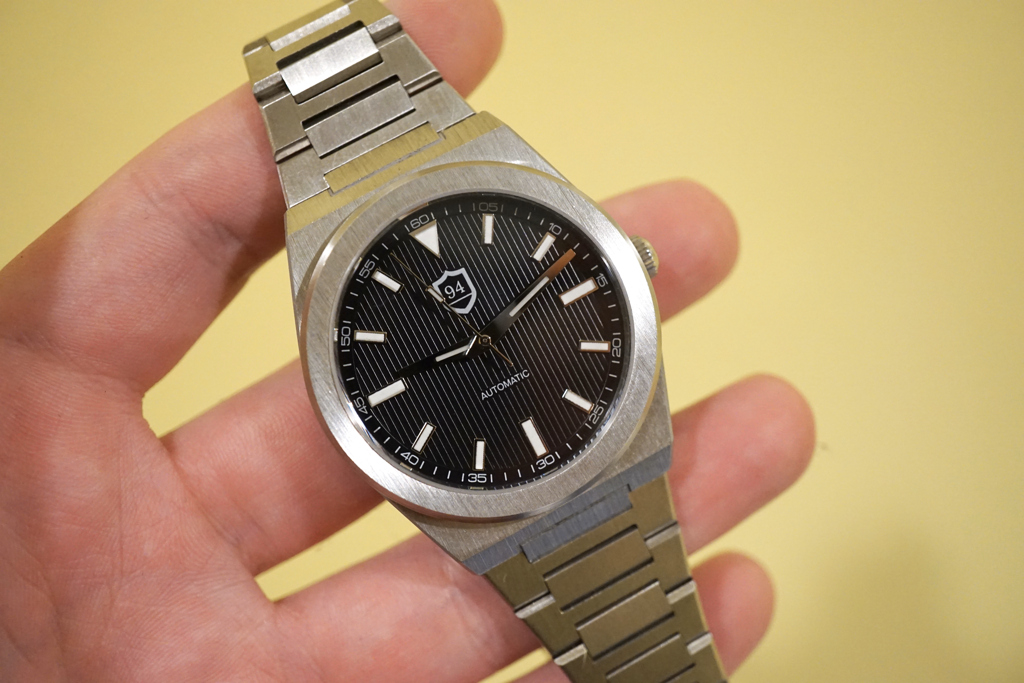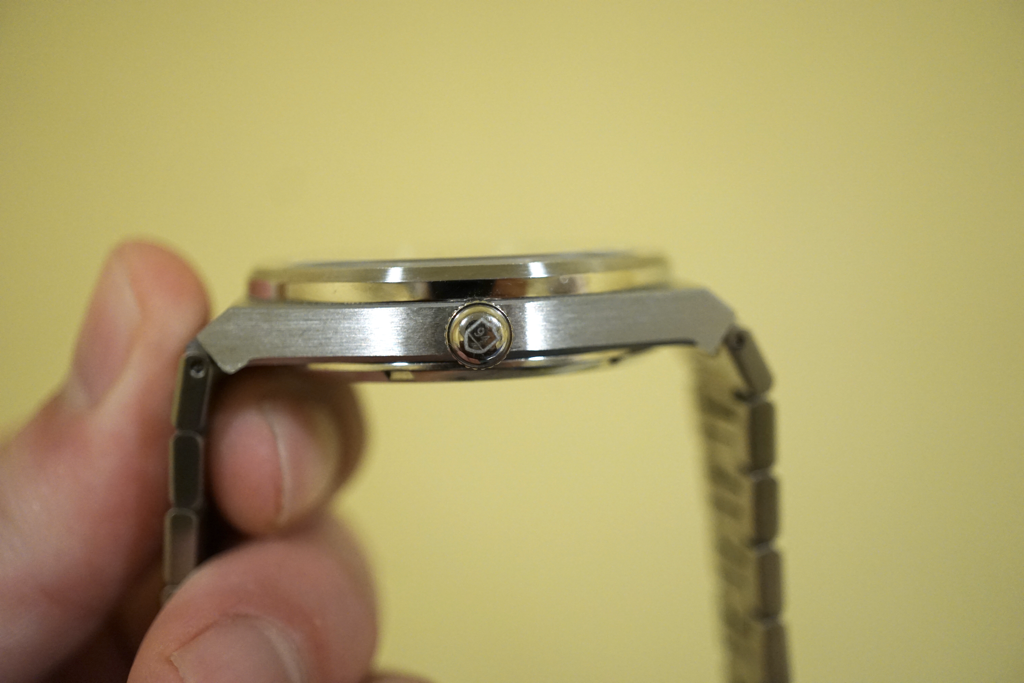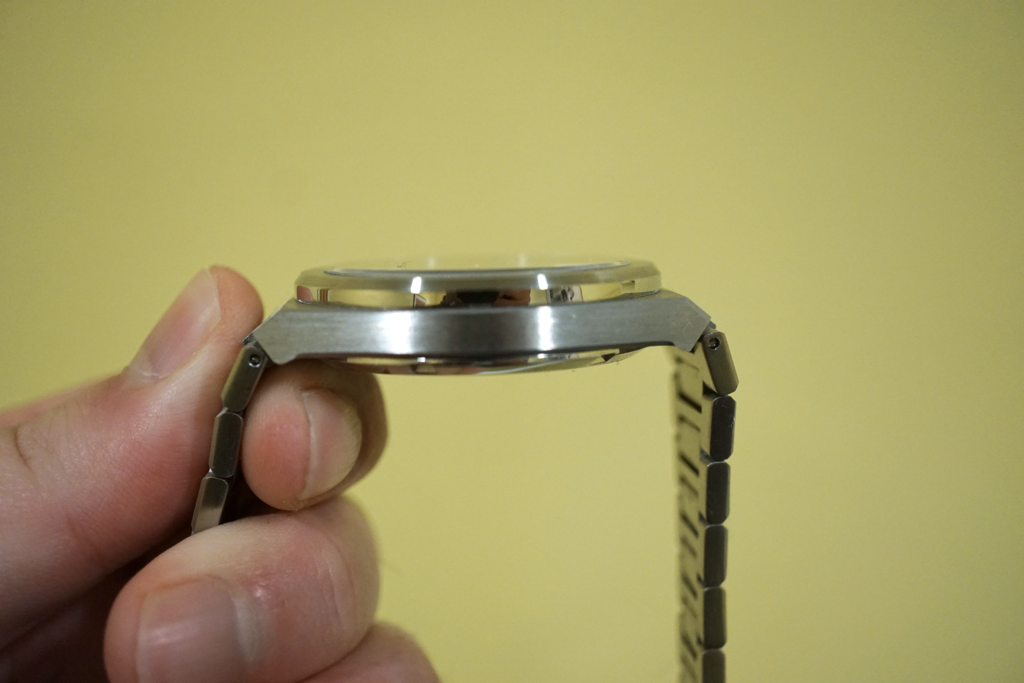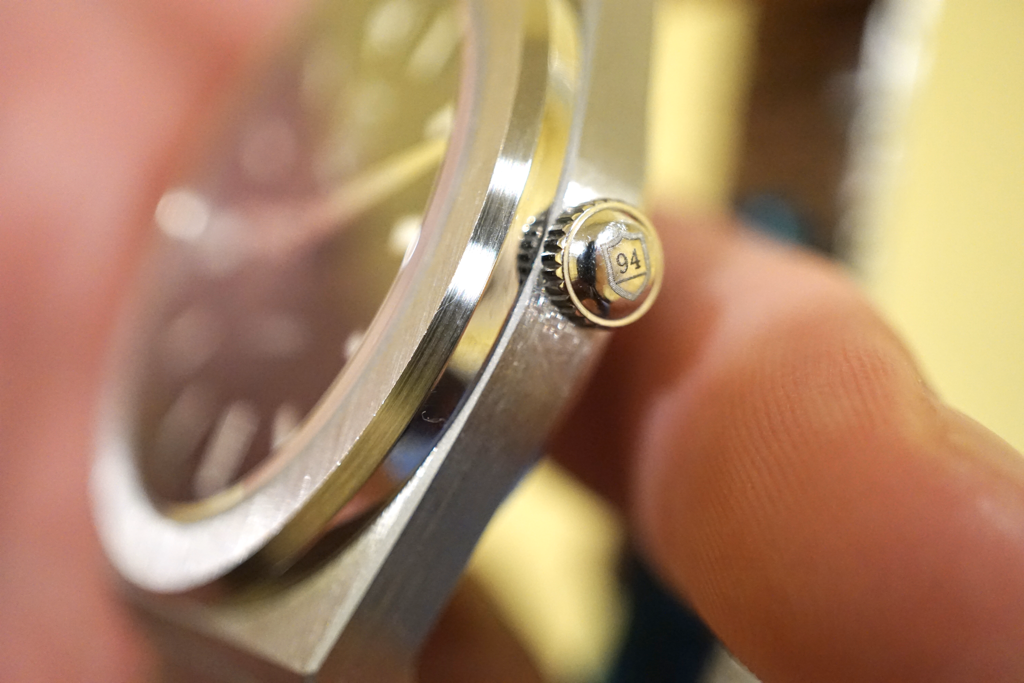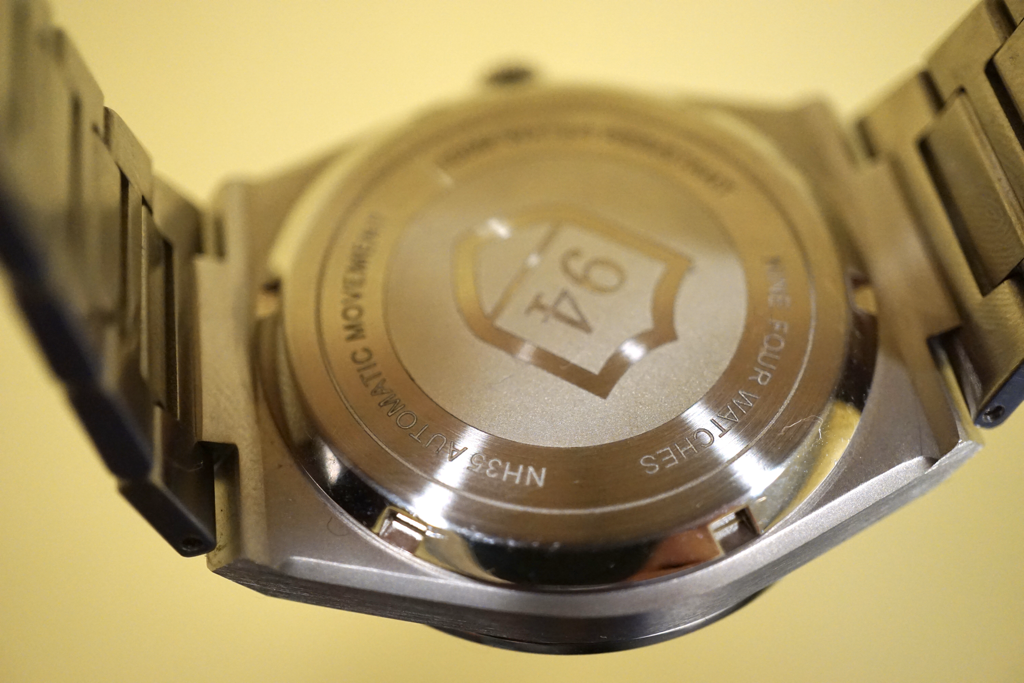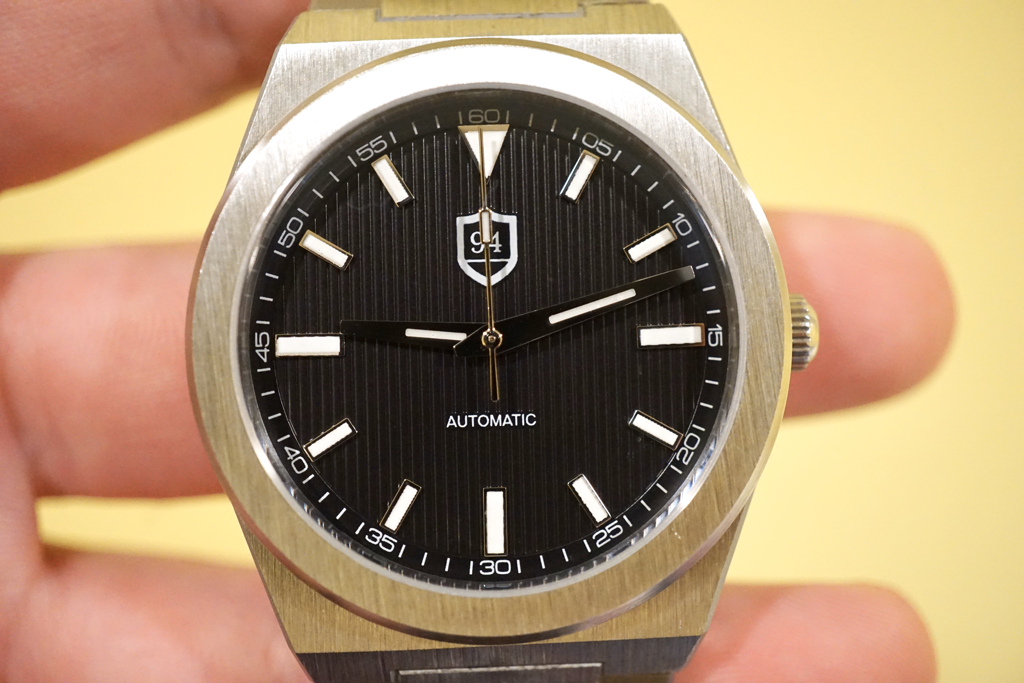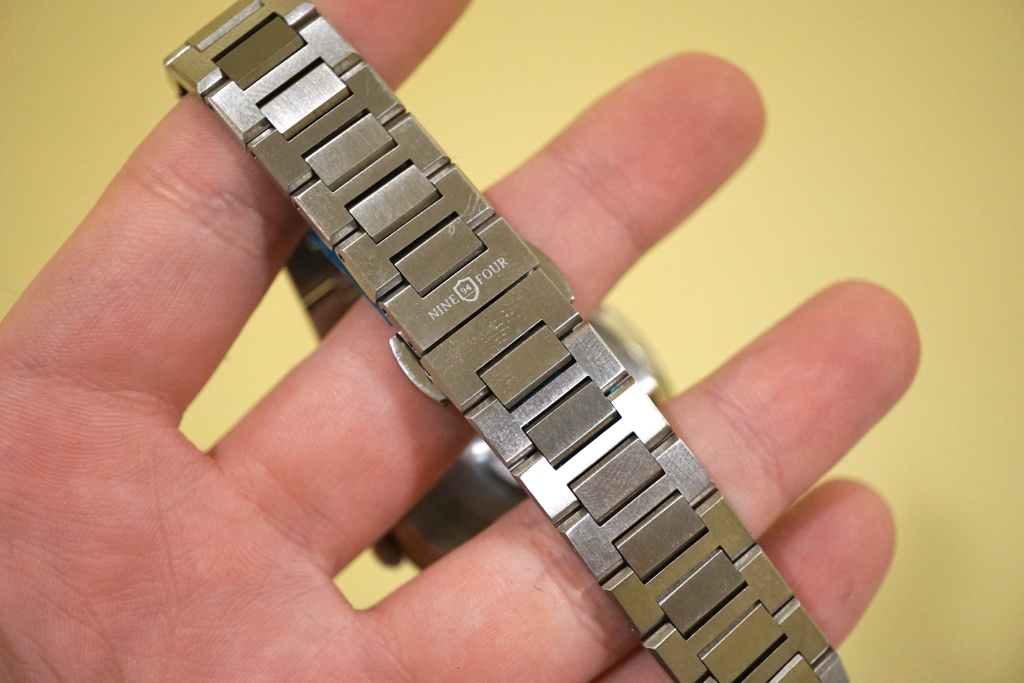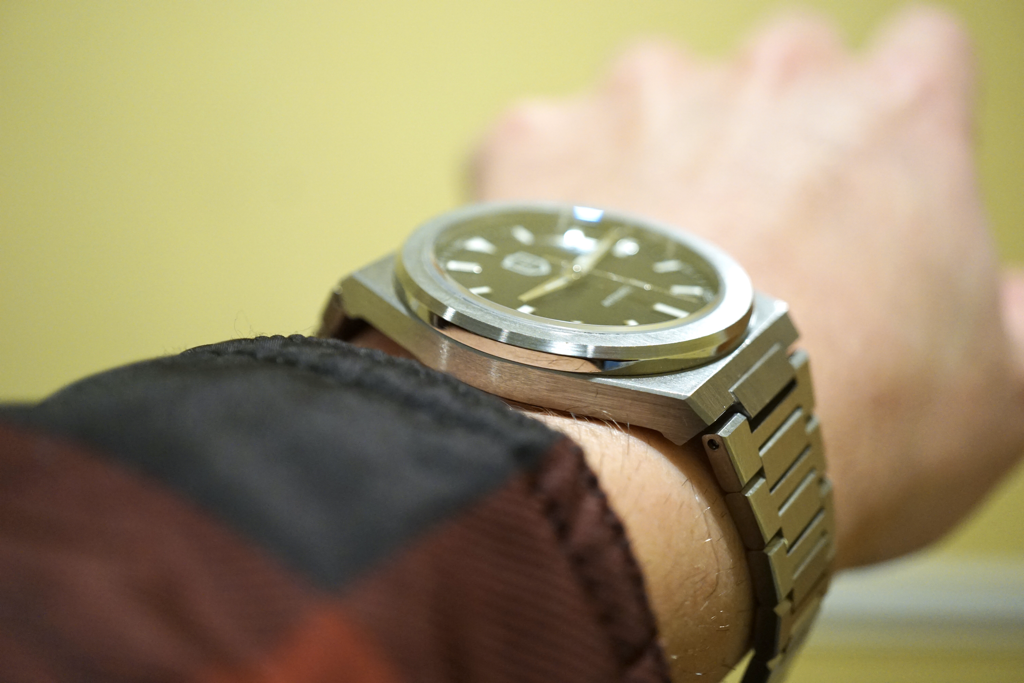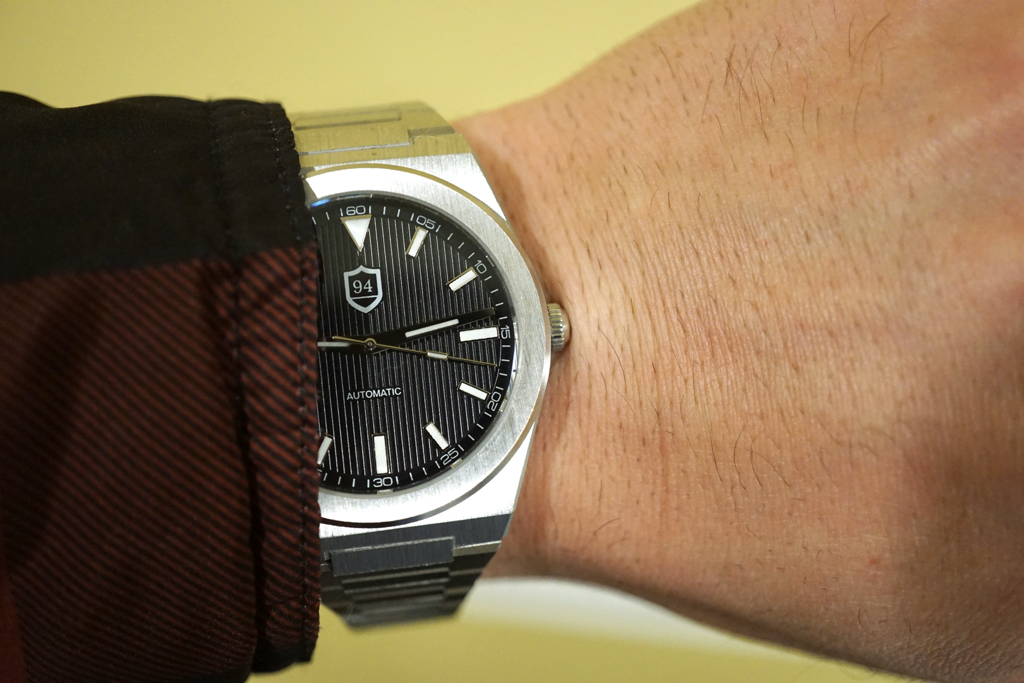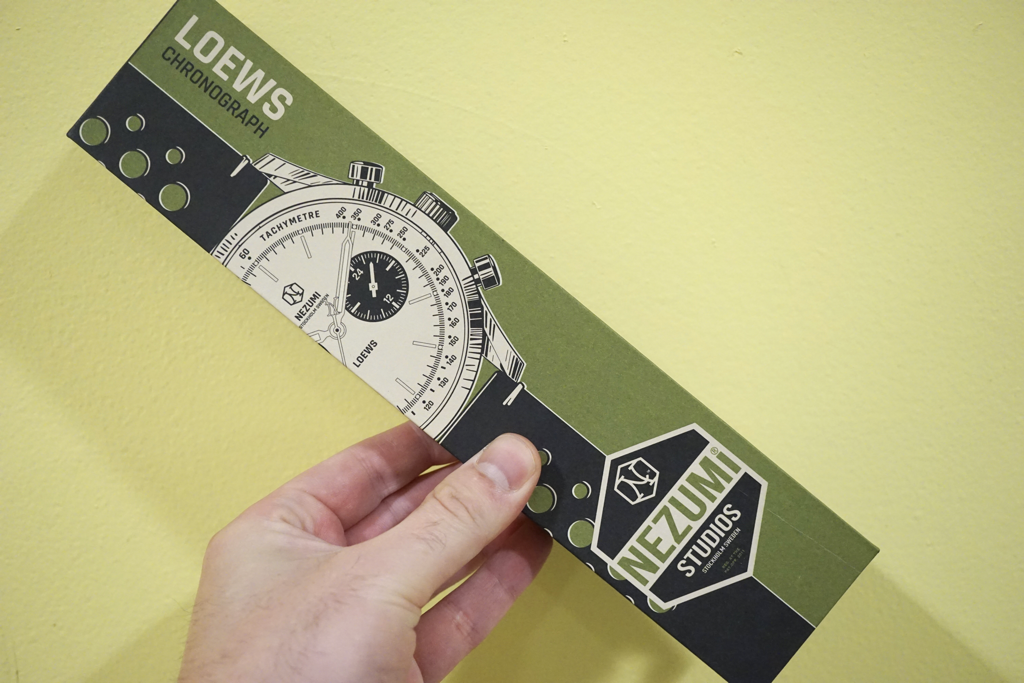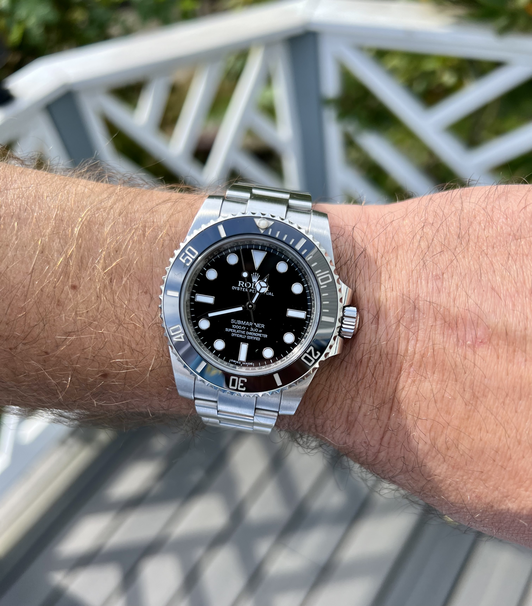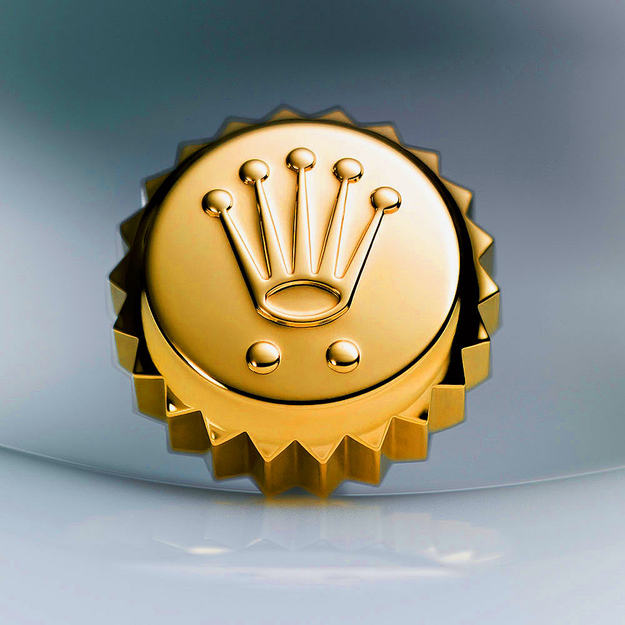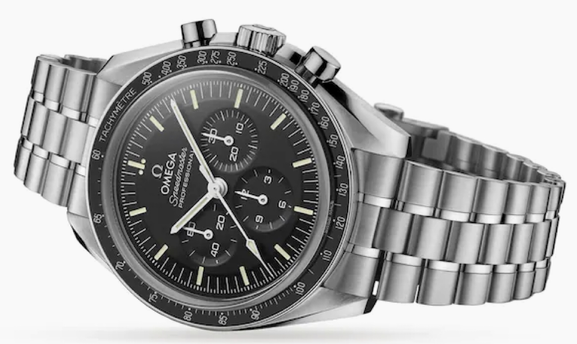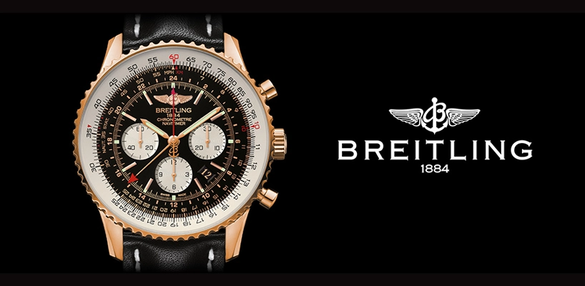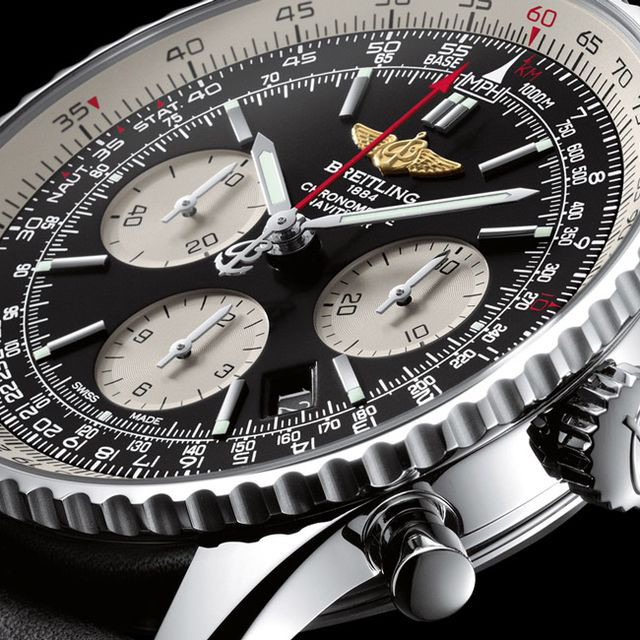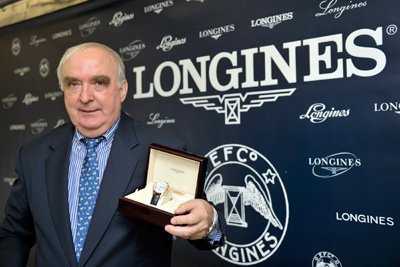Available for Pre Order March 1st $199CaseThe case of the new successor by 94 is comprised of solid brushed stainless steel with dimensions of 40MM x 10.5MM tall. The style of this watch itself is kind of a Gerald Genta ish mixup between 94 and typical luxury genta designs, which is not a bad thing, just means you can buy something similar in aesthetic but also with the DNA of 94s designer. The brushing is decent and does not feature any sharp edges nor blemishes which I found quite nice at this $199 Pre Order price. Another good note is the 100M of water resistance which is a must for many watch buyers who know what water resistance actually means. This watch can definitely be used to swim with which helps many living in hot environments where water activities are the norm. The caseback is rather simple, screwed down - while the crown is pull and push signed with the 94 logo. DialThe dial is very symmetric which I appreciate without a date cutout. This black dial features applied legible C3 lume filled markers and long polished lume filled hands. The dial features a horizontal plank design which is seen in many luxury watches from Omega and such. I happen to like it and think it fits the watches personally just fine. We do get a nice flat sapphire crystal with inner anti-reflective coating which works wonders under the light and in the sun. Getting to the lume , the C3 glows just fine but do not expect seiko bright lume. However, for this type of watch, it is acceptable and the lume can still be utilized just fine. Some changes that may be taking place may be a Applied 94 logo instead of the printed one this dial currently has. Overall, it is extremely legible, versatile, meaning it can be worn in many situations from a suit to shorts. MovementThe NH36 automatic movement is used in the successor, and for good reason. This movement features self-winding, hacking seconds, and very good accuracy. It is one of those movements that can go years and years without any issue. The movement contains 24 jewels and beats at 3HZ which equals 21,600 BPH for a smooth sweep of the seconds hand. This model itself is gaining around 5 seconds a day which is perfectly fine for me! Integrated BraceletThe bracelet had to be good on this model, because it is integrated. And the bracelet is sleek, curves nice to the wrist and features a real solid clamp down with the installed dual button butterfly clasp. The fluidity is also quite good and it curves nicely on my 6.5" wrist. Utilizing pins it is easy for any novice to adjust and seems sturdy enough for me. I think they did a good job on the bracelet which many brands going for this design fail at. The bracelet wears just as slim as the 10.5MM case without adding bulk - and I congratulate them for that. ConclusionFurthermore, I think 94 is onto something good here, and I do not see a reason why they should not be successful with the release of this model. I like all of the great specs for the $200 price, and you should too. I mean, it does check ALL of those boxes we watch nuts look for when searching for the best affordable watch we can get for our money...Best of luck to 94.
5 Comments
|
Archives
February 2024
|
ROLEX HISTORY
Rolex is a Swiss luxury watch brand that was founded in 1905 by Hans Wilsdorf and Alfred Davis in London, England. The company originally began as Wilsdorf and Davis, but it was later renamed to Rolex in 1908.
The first Rolex watches were not manufactured in-house, but instead were made by other watchmakers and then branded with the Rolex name. However, Wilsdorf had a vision of creating a wristwatch that was both reliable and accurate, and he set out to develop his own movements.
In 1910, Rolex became the first wristwatch to receive the Swiss Certificate of Chronometric Precision, which was a testament to the accuracy of the watch. Over the years, Rolex continued to innovate and develop new technologies and features, such as the first waterproof wristwatch in 1926, the first self-winding mechanism in 1931, and the first wristwatch with a date display in 1945.
Rolex has also been associated with several famous individuals, including explorers, athletes, and celebrities. For example, Sir Edmund Hillary and Tenzing Norgay wore Rolex watches when they became the first people to reach the summit of Mount Everest in 1953. Rolex has also been the official timekeeper of several sporting events, including Wimbledon and the Formula 1 Grand Prix.
Today, Rolex is one of the most recognized and respected luxury watch brands in the world, known for its quality, precision, and timeless style.
The first Rolex watches were not manufactured in-house, but instead were made by other watchmakers and then branded with the Rolex name. However, Wilsdorf had a vision of creating a wristwatch that was both reliable and accurate, and he set out to develop his own movements.
In 1910, Rolex became the first wristwatch to receive the Swiss Certificate of Chronometric Precision, which was a testament to the accuracy of the watch. Over the years, Rolex continued to innovate and develop new technologies and features, such as the first waterproof wristwatch in 1926, the first self-winding mechanism in 1931, and the first wristwatch with a date display in 1945.
Rolex has also been associated with several famous individuals, including explorers, athletes, and celebrities. For example, Sir Edmund Hillary and Tenzing Norgay wore Rolex watches when they became the first people to reach the summit of Mount Everest in 1953. Rolex has also been the official timekeeper of several sporting events, including Wimbledon and the Formula 1 Grand Prix.
Today, Rolex is one of the most recognized and respected luxury watch brands in the world, known for its quality, precision, and timeless style.
OMEGA Watches History
Omega is a Swiss luxury watch brand founded in 1848 by Louis Brandt in La Chaux-de-Fonds, Switzerland. The brand initially operated under the name La Generale Watch Co. and produced pocket watches.
In 1894, Omega revolutionized the watch industry with the introduction of the 19-ligne Omega Calibre, which was more accurate and reliable than any other watch movement of the time. This innovation earned Omega numerous awards and accolades, and the brand quickly became known for its precision and quality.
In 1903, Omega was chosen as the official timekeeper for the Gordon Bennett Cup, an international balloon race. This marked the beginning of Omega's long-standing relationship with sports timing and its reputation as a reliable and accurate timekeeper.
In 1932, Omega became the first brand to be awarded the Olympic Cross of Merit for its outstanding contribution to sports timing at the Olympic Games. Since then, Omega has been the official timekeeper for numerous Olympic Games, and its timekeeping technology has continued to evolve and improve.
In the 1950s and 1960s, Omega's watches were worn by famous explorers and adventurers, including Sir Edmund Hillary and Tenzing Norgay during their ascent of Mount Everest in 1953, and Jacques Cousteau during his underwater expeditions.
In the 1960s, Omega introduced the Speedmaster, a chronograph watch that was originally designed for motorsports but became famous as the first watch worn on the moon during the Apollo 11 mission in 1969. The Speedmaster has since become one of Omega's most iconic and sought-after models.
Today, Omega continues to innovate and produce high-quality watches, including the Seamaster, Constellation, and De Ville collections. The brand also continues to be the official timekeeper for numerous sporting events, including the Olympic Games and the America's Cup.
In 1894, Omega revolutionized the watch industry with the introduction of the 19-ligne Omega Calibre, which was more accurate and reliable than any other watch movement of the time. This innovation earned Omega numerous awards and accolades, and the brand quickly became known for its precision and quality.
In 1903, Omega was chosen as the official timekeeper for the Gordon Bennett Cup, an international balloon race. This marked the beginning of Omega's long-standing relationship with sports timing and its reputation as a reliable and accurate timekeeper.
In 1932, Omega became the first brand to be awarded the Olympic Cross of Merit for its outstanding contribution to sports timing at the Olympic Games. Since then, Omega has been the official timekeeper for numerous Olympic Games, and its timekeeping technology has continued to evolve and improve.
In the 1950s and 1960s, Omega's watches were worn by famous explorers and adventurers, including Sir Edmund Hillary and Tenzing Norgay during their ascent of Mount Everest in 1953, and Jacques Cousteau during his underwater expeditions.
In the 1960s, Omega introduced the Speedmaster, a chronograph watch that was originally designed for motorsports but became famous as the first watch worn on the moon during the Apollo 11 mission in 1969. The Speedmaster has since become one of Omega's most iconic and sought-after models.
Today, Omega continues to innovate and produce high-quality watches, including the Seamaster, Constellation, and De Ville collections. The brand also continues to be the official timekeeper for numerous sporting events, including the Olympic Games and the America's Cup.
BREITLING Watches History
Breitling is a Swiss luxury watch brand that was founded in 1884 by Léon Breitling in the town of Saint-Imier in the Canton of Bern, Switzerland. Initially, the company specialized in producing chronographs and other precision timepieces for scientific and industrial purposes.
In 1915, Breitling introduced the first wrist-worn chronograph with a separate pusher to control the start, stop, and reset functions, which made it easier to use than previous models. This innovation helped establish Breitling as a leading maker of chronographs and other precision timepieces.
During the 1930s and 1940s, Breitling continued to innovate with the introduction of the first chronograph with a second independent pusher, which allowed for the recording of multiple elapsed times. The company also developed the Huit Aviation Department, which produced wristwatches for pilots and other aviation professionals.
In the 1950s, Breitling introduced the Navitimer, a wristwatch with a built-in slide rule that allowed pilots to perform complex calculations in-flight. The Navitimer became an instant classic and remains one of Breitling's most popular models to this day.
In the 1960s, Breitling continued to produce innovative timepieces, including the Chrono-Matic, which was the first automatic chronograph movement with a micro-rotor. The company also introduced the Emergency, a wristwatch with a built-in distress beacon that could be activated in case of an emergency.
In the years since, Breitling has continued to produce innovative and high-quality timepieces for a variety of applications, including aviation, diving, and sports. The company has also maintained a strong commitment to precision and accuracy, with many of its watches featuring COSC-certified movements. Today, Breitling is recognized as one of the world's leading luxury watch brands, with a reputation for innovation, quality, and style.
In 1915, Breitling introduced the first wrist-worn chronograph with a separate pusher to control the start, stop, and reset functions, which made it easier to use than previous models. This innovation helped establish Breitling as a leading maker of chronographs and other precision timepieces.
During the 1930s and 1940s, Breitling continued to innovate with the introduction of the first chronograph with a second independent pusher, which allowed for the recording of multiple elapsed times. The company also developed the Huit Aviation Department, which produced wristwatches for pilots and other aviation professionals.
In the 1950s, Breitling introduced the Navitimer, a wristwatch with a built-in slide rule that allowed pilots to perform complex calculations in-flight. The Navitimer became an instant classic and remains one of Breitling's most popular models to this day.
In the 1960s, Breitling continued to produce innovative timepieces, including the Chrono-Matic, which was the first automatic chronograph movement with a micro-rotor. The company also introduced the Emergency, a wristwatch with a built-in distress beacon that could be activated in case of an emergency.
In the years since, Breitling has continued to produce innovative and high-quality timepieces for a variety of applications, including aviation, diving, and sports. The company has also maintained a strong commitment to precision and accuracy, with many of its watches featuring COSC-certified movements. Today, Breitling is recognized as one of the world's leading luxury watch brands, with a reputation for innovation, quality, and style.
Longines
Longines is a Swiss luxury watch company that was founded in 1832 by Auguste Agassiz in the town of Saint-Imier, Switzerland. The company has a long and prestigious history in the world of watchmaking, and has been responsible for many innovations and milestones in the industry.
In the early days, Longines primarily produced pocket watches, and quickly gained a reputation for precision and accuracy. By the end of the 19th century, Longines had become one of the leading watchmakers in the world. In 1912, the company introduced the first chronograph wristwatch, which was quickly adopted by the military and aviation communities.
In the 1920s and 1930s, Longines continued to innovate with the introduction of the world's first quartz clock and the first wristwatch with an automatic winding mechanism. During World War II, Longines produced wristwatches for the British Royal Air Force, and continued to produce military watches for several decades afterwards.
In the post-war years, Longines became known for its elegant and sophisticated watches, particularly its "Conquest" line of watches. In the 1950s and 1960s, Longines was a favorite of celebrities and politicians, and its watches were frequently seen on the wrists of Elvis Presley, John F. Kennedy, and other famous figures.
In recent years, Longines has continued to produce high-quality watches that combine traditional Swiss craftsmanship with modern technology. The company is particularly known for its sport watches, including its "HydroConquest" line of diving watches and its "Conquest Classic" line of chronographs.
Today, Longines is owned by the Swatch Group, and remains a leading brand in the luxury watch industry. Its watches are prized for their precision, reliability, and timeless style.
In the early days, Longines primarily produced pocket watches, and quickly gained a reputation for precision and accuracy. By the end of the 19th century, Longines had become one of the leading watchmakers in the world. In 1912, the company introduced the first chronograph wristwatch, which was quickly adopted by the military and aviation communities.
In the 1920s and 1930s, Longines continued to innovate with the introduction of the world's first quartz clock and the first wristwatch with an automatic winding mechanism. During World War II, Longines produced wristwatches for the British Royal Air Force, and continued to produce military watches for several decades afterwards.
In the post-war years, Longines became known for its elegant and sophisticated watches, particularly its "Conquest" line of watches. In the 1950s and 1960s, Longines was a favorite of celebrities and politicians, and its watches were frequently seen on the wrists of Elvis Presley, John F. Kennedy, and other famous figures.
In recent years, Longines has continued to produce high-quality watches that combine traditional Swiss craftsmanship with modern technology. The company is particularly known for its sport watches, including its "HydroConquest" line of diving watches and its "Conquest Classic" line of chronographs.
Today, Longines is owned by the Swatch Group, and remains a leading brand in the luxury watch industry. Its watches are prized for their precision, reliability, and timeless style.
Tissot
Tissot is a Swiss watch brand that was founded in 1853 by Charles-Félicien Tissot and his son Charles-Émile Tissot in the town of Le Locle, Switzerland. The company has a long and rich history in the world of watchmaking, and has been responsible for many innovations and milestones in the industry.
In the early days, Tissot primarily produced pocket watches, and quickly gained a reputation for quality and precision. By the end of the 19th century, Tissot was one of the largest watchmakers in Switzerland, and was exporting its watches to countries around the world.
In the early 20th century, Tissot continued to innovate with the introduction of the first non-magnetic wristwatch, the first dual time-zone watch, and the first watch with a plastic case. During World War II, Tissot produced watches for the Allied forces, and continued to produce military watches for several decades afterwards.
In the post-war years, Tissot became known for its elegant and sophisticated watches, particularly its "Tissot Visodate" line of watches, which featured a date function and a distinctive "T" logo on the dial. In the 1970s, Tissot was one of the first Swiss watch brands to introduce quartz watches, which quickly became popular due to their accuracy and affordability.
In recent years, Tissot has continued to produce high-quality watches that combine traditional Swiss craftsmanship with modern technology. The company is particularly known for its sport watches, including its "T-Touch" line of watches, which feature touch-screen technology and a range of functions such as altimeter, compass, and thermometer.
Today, Tissot is part of the Swatch Group, and remains a leading brand in the watch industry. Its watches are prized for their quality, durability, and stylish design, and are worn by watch enthusiasts and collectors around the world.
In the early days, Tissot primarily produced pocket watches, and quickly gained a reputation for quality and precision. By the end of the 19th century, Tissot was one of the largest watchmakers in Switzerland, and was exporting its watches to countries around the world.
In the early 20th century, Tissot continued to innovate with the introduction of the first non-magnetic wristwatch, the first dual time-zone watch, and the first watch with a plastic case. During World War II, Tissot produced watches for the Allied forces, and continued to produce military watches for several decades afterwards.
In the post-war years, Tissot became known for its elegant and sophisticated watches, particularly its "Tissot Visodate" line of watches, which featured a date function and a distinctive "T" logo on the dial. In the 1970s, Tissot was one of the first Swiss watch brands to introduce quartz watches, which quickly became popular due to their accuracy and affordability.
In recent years, Tissot has continued to produce high-quality watches that combine traditional Swiss craftsmanship with modern technology. The company is particularly known for its sport watches, including its "T-Touch" line of watches, which feature touch-screen technology and a range of functions such as altimeter, compass, and thermometer.
Today, Tissot is part of the Swatch Group, and remains a leading brand in the watch industry. Its watches are prized for their quality, durability, and stylish design, and are worn by watch enthusiasts and collectors around the world.


